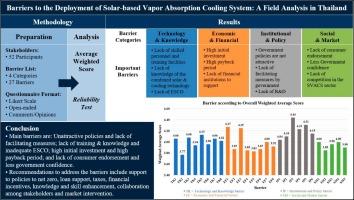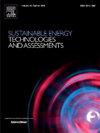Barriers to the deployment of solar-based vapor absorption cooling system: A field analysis in Thailand
IF 7.1
2区 工程技术
Q1 ENERGY & FUELS
Sustainable Energy Technologies and Assessments
Pub Date : 2024-09-23
DOI:10.1016/j.seta.2024.103995
引用次数: 0
Abstract
About 60% of the electricity consumption in commercial buildings in Thailand is for air conditioning. The growth of commercial building construction and the rise in global temperature increase the air conditioning demand. Solar-based vapor absorption cooling systems (SVACS) are promoted because of lower electricity consumption, greenhouse gas mitigation, and natural refrigerant use. However, its adoption is minimal in Thailand. This study identified the barriers to deploying SVACS through surveys and feedback from various stakeholders. The barriers are categorized as Technology and Knowledge, Economic and Financial, Institutional and Policy, and Social and Market. 27 barriers were identified from the literature and discussions with stakeholders. Key barriers are lack of attractive policies and facilitating measures. Other important barriers include lack of training and knowledge, high investment and payback period, and lack of consumer and government confidence. Barriers unique to Thailand are also listed. SWOT (strengths, weaknesses, opportunities, threats) analysis shows the major strength of SVACS is the reduction of both electricity demand and emissions, while the major challenges are high payback period and system complexity. Recommendations to address the barriers include support to net zero, providing financial support, carbon taxation, knowledge and skill enhancement, increasing collaboration among sectors/stakeholders, and market intervention.

使用太阳能蒸汽吸收冷却系统的障碍:泰国实地分析
泰国商业建筑约 60% 的耗电量用于空调。商业建筑的增长和全球气温的升高增加了对空调的需求。太阳能蒸汽吸收冷却系统(SVACS)因耗电量低、减少温室气体排放和使用天然制冷剂而得到推广。然而,这种系统在泰国的应用却很少。本研究通过调查和各利益相关方的反馈,确定了部署 SVACS 的障碍。这些障碍分为技术和知识、经济和财务、机构和政策以及社会和市场。从文献和与利益相关者的讨论中确定了 27 个障碍。主要障碍是缺乏有吸引力的政策和促进措施。其他重要障碍包括缺乏培训和知识、投资和回收期过长以及消费者和政府缺乏信心。此外,还列出了泰国特有的障碍。SWOT(优势、劣势、机会、威胁)分析表明,SVACS 的主要优势在于减少电力需求和排放,而主要挑战在于投资回收期长和系统复杂。应对障碍的建议包括支持净零排放、提供财政支持、征收碳税、提高知识和技能、加强部门/利益相关者之间的合作以及市场干预。
本文章由计算机程序翻译,如有差异,请以英文原文为准。
求助全文
约1分钟内获得全文
求助全文
来源期刊

Sustainable Energy Technologies and Assessments
Energy-Renewable Energy, Sustainability and the Environment
CiteScore
12.70
自引率
12.50%
发文量
1091
期刊介绍:
Encouraging a transition to a sustainable energy future is imperative for our world. Technologies that enable this shift in various sectors like transportation, heating, and power systems are of utmost importance. Sustainable Energy Technologies and Assessments welcomes papers focusing on a range of aspects and levels of technological advancements in energy generation and utilization. The aim is to reduce the negative environmental impact associated with energy production and consumption, spanning from laboratory experiments to real-world applications in the commercial sector.
 求助内容:
求助内容: 应助结果提醒方式:
应助结果提醒方式:


